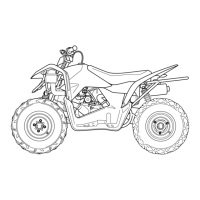PERIODIC
MAINTENANCE
2-29
COMPRESSION PRESSURE CHECK
The compression pressure reading of a cylinder is a good indicator
of
its internal condition.
The decision to overhaul the cylinder is often based on the results
of
a compression test. Periodic mainta·
nance records kepi at your dealership should include compression readings for each maintenance seNies.
~
Compression
pressure
:
Standard: 1
000 kPa (10.0
kgf/cm
2
,
142 psi)
(Automatic
decompression
actuated)
Low
compression
pressure
can
indicate
any
of
the
following
conditions
:
• Excessively worn cylinder walts
•
Worn piston or piston rings
• Piston rings stuck in grooves
• Poor valve seating
• Ruptured
or
othelWise defective cylinder head gasket
NOTE:
When
the
compression pressure goes below specification, check the engine for conditions listed above.
COMPRESSION TEST PROCEDURE
NOTE:
• Before testing the engine for compression pressure, make
sure that
the
cylinder head nuts are tightened
to
the specified
torque values and the valves
are properly adjusted.
• Warm up the engine before testing.
• Make sure that the battery
is
fully charged.
Remove the related parts and test the compression pressure
in
the
following manner.
• Remove Ihe spark plug.
(c:72-
10)
• Install
the compression gauge and adaptor
in
the spark plug
hole. Make sure that the connection
is
tight.
• Keep the throttle lever
in
the
fu
lly open position.
• Press the sta
rt
er bu
t10n
and crank the engine for a few sec-
onds. Record t
he
maximum gauge reading as
the
cylinder
compression.
dIJ
09915-64512:
Compression
gauge
set
09915-63310:
Adaptor
,.
,

